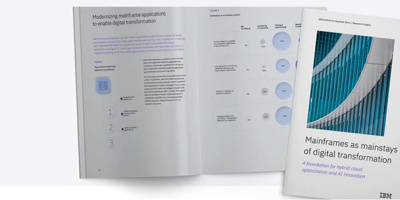Artificial Intelligence may seem frightful, but the practical applications for it, particularly in business, are expanding, and some say the possibilities are limitless. A clear-eyed look at the true state of AI business projects shows more reason for optimism than fear.
Artificial Intelligence (AI) has had a somewhat dark reputation over the past few decades. It doesn't help that it's traditionally gotten a bad rap from Western culture. Films are a prime example. Beginning with HAL 9000 in 2001: A Space Odyssey (1968), Colossus in The Forbin Project (1970), and SkyNet in the Terminator films, just to name a few, AI is often portrayed as a technology bound to go wrong and threaten or doom the human species somehow. Couple that with countless sci-fi novels and stories in which humanity is portrayed as little more than a launch point for the silicon-based machine lifeform that will succeed us…well, it's little wonder that some people are afraid of AI in the aggregate. That's not to mention the fears that any new technology will "eliminate my job," which have been with us at least since the advent of the powered loom in 1785.
But as surely as Alexa can tell you your local grocery store hours, real AI is here and its use in the business realm, at least, has already reached the point of inevitability. Rather than being the monster under the bed, AI is more accurately viewed as a tool that will transform how companies make money and ultimately how many of us will live our lives in the future.
This two-part article series will examine what’s involved in developing an AI project, ways such projects can succeed, some of the pitfalls, and a look ahead to the potential benefits AI projects can bring to business.
Finding and Reaping the Benefits of an AI Project
One evangelist for the benefits of AI is Paolo Righetti, Head of Analytics at Teleperformance/Teleperformance Knowledge Services (TKS), headquartered in Italy and specializing in consultancy projects, many of which automate B2B and B2C companies that rely heavily on the use of telephone agents to transact business with their customers. TKS has been involved in numerous AI implementation projects over the past 10 years and provides some insights into the successes and stumbling blocks for AI automation efforts.
Righetti describes TKS as "the operational consulting division of Teleperformance Company," which is able to "go into an organization, assess the situation, and basically operate a transformation…leveraging analytics, automation, and change that is able to produce a measurable return on investment (ROI)." TKS's clients, according to Righetti, are speeding up their digital transformation to become enterprises that are using digital and AI to improve their operations and produce a better bottom line.
TKS uses, among other techniques, customer interaction analytics, the study and evaluation of communications interchanges between customers and providers in the course of conducting commercial transactions. While this field doesn't apply to all enterprises that might benefit from AI, TKS's experience is a useful template for examining broader trends in AI project implementation.
Righetti identifies the "pillars" of any AI project as consulting, analytics, automation, and training. Consulting is the end-to-end glue that assesses the as-is, designs the to-be, and supports the deployment optimizing the ROI. Analytics is the process of gathering and validating business data—for example, data about a business' interactions with its customers. Automation is the process, which covers everything from "automation of simple tasks to automation that is driven by AI" and "automation with decision-making processes delegated to AI tools," Righetti says. Training is the process of not simply educating workers in new processes and procedures but also using the inputs from predictive analytics to uncover the gaps in training for each individual worker.
One method TKS uses for training analysis is a talent questionnaire of approximately 80 queries that, depending on employee answers, shows personality microtraits "that will tell us if the person is suitable to do customer care, to seeking clients in a specific culture, to working on a technical desk, to working in a channel," Righetti says. TKS has used this questionnaire to determine where job applicants to the company would best fit in the spectrum of job functions available there. After five years of development and modification, TKS has started using this method at customer sites to help determine the most efficient deployment of a client company's personnel in a post-AI adoption environment. Righetti reports that this method improves performance, shortens the learning curve, and decreases absences among employees hired via traditional recruiting and interview methods.
"With the training and the change management that goes around the design of the process engagements of the recruiters," Righetti notes, "we have improved globally the way we normally recruit and allocate people into the right positions, thanks to an AI system that is augmenting our human recruiters. We discovered that because of different customer bases, expectations, pressures, cultures, and requests, even positions that look the same (to a human recruiter) become different when viewed through the AI lens."
The Stages of an AI Development Effort
Righetti breaks down an AI project into four basic steps: assessment, modeling, designing and piloting a new process, and deployment. Each step must be completed successfully before moving on to the next one.
"For me, an AI development effort is not a software development effort," Righetti emphasizes. "An AI development effort is [assessing] a business and understanding if we have good chances of transforming this business with the tools we have available."
The assessment phase is similar to systems analysis, in which the current business processes are reviewed and opportunities for automating those processes with an AI solution are determined. The outcome of the assessment is a report that says what actions would be taken, the time frame, the expected outcome, and the ROI.
The next phase, modeling, involves extracting data holistically from company systems and, in the case of analyzing commercial processes, predicting the likelihood that customer complaints may arise from any current procedure. The goal here is, "we don't want to wait for a customer to complain. We want to take actions that will delight customers instead," Righetti explains. TKS is looking to establish "how much intelligence, how much ability to predict, and how much potential energy we have in the data set." This step evaluates how accurate the hypotheses formed in the assessment phase look when augmented by real figures. A project will advance beyond this point "only if we think there are enough chances within the data set, the problem statement, and the processes, to deliver value," Righetti says.
The next step, designing and piloting a new process, "is basically different because it embeds incremental information that didn't previously exist," Righetti notes, information that has been unearthed in the previous two steps by AI experts. Most often, this step shows proof of concept to the client by automating some process with AI and showing an improvement because of that effort. For TKS, this step answers questions such as whether the project is generating the expected ROI and whether the project can provide enough value compared to its cost.
"When you have enough experience at the assessment stage, you already know the probability you have to deliver a certain value and to achieve a certain result," Righetti reveals. "We stop pilots that would deliver failure as a result. Although, it's not the pilot itself, it's how you get to the pilot that determines the success of the pilot. You learn about the operating conditions with the pilot. If you are doing change, you need to be allowed to drive this change. You need to be free to operate and to deploy what has been designed during the assessment."
The final step is deployment, followed by an ongoing optimization process that looks to develop incremental improvements as the client company evaluates each procedural change. This step also includes figuring out who at the client company is going to be responsible for monitoring the processes and continuing to champion improvements to increase value on an ongoing basis.
It's Not Easy to Be Transformative
One of the biggest hurdles to overcome, Righetti admits, is departmental silos and interdepartmental politics. The siloing problem originates from departments feeling that they "own" certain data and overcoming what may be preexisting tendencies to not share that data with other groups.
These and other political issues between departments can damage the potential ROI for an AI project, Righetti warns.
"If the data's not shared, typically, you are giving to the system and to the project only one third, one fourth, or one fifth of the chances to succeed" because the project isn't using all of the information available. In fact, Righetti compares an AI project to developing a new brain for the enterprise.
"The AI part of the organization is the prefrontal cortex, which is the part of the brain where the human being makes hypotheses, probabilities, and…decisions," Righetti believes. "The AI is this inside a company."
However, when a project makes it through all four steps, the results can be dramatic. Righetti cites an example at one customer site where "we were able to really do a perfect AI project with a client that worked all the silos within their organization….Thanks to this AI holistic effort, it broke the silence. It changed the way the company operated completely. It changed the organization, the meetings. The AI became the heart of all the decision-making processes of the company," Righetti recalls. "Today the person that was in charge of the program…and a special department solely dedicated to this process [are] reporting directly to the CEO" and aren’t part of any other functional division of the company.
How long an AI project can take varies with the size and needs of the client company.
"A simple sales process might take weeks and be done. How to optimize a retention process can take months because just measuring the outcome of the retention takes months," Righetti says.
The techniques, and even the software used, can also vary. TKS includes a group that watches AI software developments carefully and benchmarks any new solutions the company thinks might be useful in future projects. TKS draws from this knowledge base in deciding what solution to offer each client.
"There are a lot of brilliant platforms, and there are new solutions coming out every month. It is difficult to keep up and benchmark solutions. We have a wide range of solutions, from in-house development to partnership with third parties," Righetti explains. The most successful method is to "understand in the assessment phase which is the right solution that has the lowest possible costs and that lets you get the best possible results." Consequently, Righetti feels he can't point to any one platform as an ideal one for any AI project.
Determining Project Success
Part of any development project is defining what "success" means.
"A successful project is a project that has reached the expected ROI. When we build the assessment, we build the business case. We have an expectation of how many costs we are incurring, because the ROI takes up value costs from the change," Righetti says. "We see how much we expect to be able to use this potential information to drive change and how much value the change will generate. We are successful if we achieve the target ROI."
Editor’s Note: Part 2 of this article will be published in a future edition of Systems Insight.























 More than ever, there is a demand for IT to deliver innovation. Your IBM i has been an essential part of your business operations for years. However, your organization may struggle to maintain the current system and implement new projects. The thousands of customers we've worked with and surveyed state that expectations regarding the digital footprint and vision of the company are not aligned with the current IT environment.
More than ever, there is a demand for IT to deliver innovation. Your IBM i has been an essential part of your business operations for years. However, your organization may struggle to maintain the current system and implement new projects. The thousands of customers we've worked with and surveyed state that expectations regarding the digital footprint and vision of the company are not aligned with the current IT environment. TRY the one package that solves all your document design and printing challenges on all your platforms. Produce bar code labels, electronic forms, ad hoc reports, and RFID tags – without programming! MarkMagic is the only document design and print solution that combines report writing, WYSIWYG label and forms design, and conditional printing in one integrated product. Make sure your data survives when catastrophe hits. Request your trial now! Request Now.
TRY the one package that solves all your document design and printing challenges on all your platforms. Produce bar code labels, electronic forms, ad hoc reports, and RFID tags – without programming! MarkMagic is the only document design and print solution that combines report writing, WYSIWYG label and forms design, and conditional printing in one integrated product. Make sure your data survives when catastrophe hits. Request your trial now! Request Now. Forms of ransomware has been around for over 30 years, and with more and more organizations suffering attacks each year, it continues to endure. What has made ransomware such a durable threat and what is the best way to combat it? In order to prevent ransomware, organizations must first understand how it works.
Forms of ransomware has been around for over 30 years, and with more and more organizations suffering attacks each year, it continues to endure. What has made ransomware such a durable threat and what is the best way to combat it? In order to prevent ransomware, organizations must first understand how it works. Disaster protection is vital to every business. Yet, it often consists of patched together procedures that are prone to error. From automatic backups to data encryption to media management, Robot automates the routine (yet often complex) tasks of iSeries backup and recovery, saving you time and money and making the process safer and more reliable. Automate your backups with the Robot Backup and Recovery Solution. Key features include:
Disaster protection is vital to every business. Yet, it often consists of patched together procedures that are prone to error. From automatic backups to data encryption to media management, Robot automates the routine (yet often complex) tasks of iSeries backup and recovery, saving you time and money and making the process safer and more reliable. Automate your backups with the Robot Backup and Recovery Solution. Key features include: Business users want new applications now. Market and regulatory pressures require faster application updates and delivery into production. Your IBM i developers may be approaching retirement, and you see no sure way to fill their positions with experienced developers. In addition, you may be caught between maintaining your existing applications and the uncertainty of moving to something new.
Business users want new applications now. Market and regulatory pressures require faster application updates and delivery into production. Your IBM i developers may be approaching retirement, and you see no sure way to fill their positions with experienced developers. In addition, you may be caught between maintaining your existing applications and the uncertainty of moving to something new. IT managers hoping to find new IBM i talent are discovering that the pool of experienced RPG programmers and operators or administrators with intimate knowledge of the operating system and the applications that run on it is small. This begs the question: How will you manage the platform that supports such a big part of your business? This guide offers strategies and software suggestions to help you plan IT staffing and resources and smooth the transition after your AS/400 talent retires. Read on to learn:
IT managers hoping to find new IBM i talent are discovering that the pool of experienced RPG programmers and operators or administrators with intimate knowledge of the operating system and the applications that run on it is small. This begs the question: How will you manage the platform that supports such a big part of your business? This guide offers strategies and software suggestions to help you plan IT staffing and resources and smooth the transition after your AS/400 talent retires. Read on to learn:
LATEST COMMENTS
MC Press Online